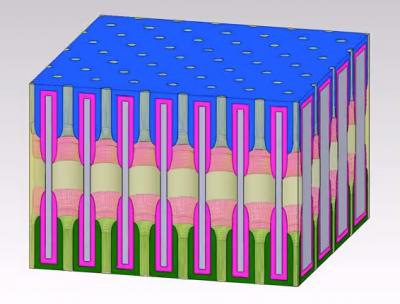A battery made up of billions of nanoscale batteries
November 11, 2014

A billion nanopores could fit on a postage stamp (credit: NEES, a DOE Energy Frontier Research Center)
Imagine a battery made up of billions of nanoscale batteries — the ultimate miniaturization of energy storage.
That’s what researchers at the University of Maryland (UMD) have invented, using a structure based on a nanopore: a tiny hole in a ceramic sheet that holds electrolyte to carry the electrical charge between nanotube electrodes at either end.
The researchers note in a paper in Nature Nanotechnology that such a design would provide the maximum power and energy from a given battery chemistry because the internal resistances for ion transfer and the volume of electrochemically inactive components would be minimized. That means smaller, more powerful batteries that operate longer without a recharge —- that is, significantly higher energy density and power density.
Chanyuan Liu, a Ph.D. student in materials science & engineering, says that it can be fully charged in 12 minutes and can be recharged thousands of time.
Many millions of these nanobatteries can be crammed into one larger battery the size of a postage stamp. Each nanopore is shaped just like the others, which allows them to pack the tiny thin batteries together efficiently.
They are all connected in parallel, each composed of an anode, a cathode, and a liquid electrolyte confined within the nanopores of anodic aluminium oxide,

Each end of the tiny pore is treated to add nanotubes that collect the electrical charge conducted by the liquid electrolyte filling the pore (credit: NEES, a DOE Energy Frontier Research Center)
The space inside the holes is so small that the space they take up, all added together, would be no more than a grain of sand.
Now that the scientists have the battery working and have demonstrated the concept, they have also identified improvements that could make the next version 10 times more powerful.
The next step to commercialization: manufacturing the battery in large batches.
The research was funded by the Department of Energy.
Abstract of An all-in-one nanopore battery array
A single nanopore structure that embeds all components of an electrochemical storage device could bring about the ultimate miniaturization in energy storage. Self-alignment of electrodes within each nanopore may enable closer and more controlled spacing between electrodes than in state-of-art batteries. Such an ‘all-in-one’ nanopore battery array would also present an alternative to interdigitated electrode structures that employ complex three-dimensional geometries with greater spatial heterogeneity. Here, we report a battery composed of an array of nanobatteries connected in parallel, each composed of an anode, a cathode and a liquid electrolyte confined within the nanopores of anodic aluminium oxide, as an all-in-one nanosize device. Each nanoelectrode includes an outer Ru nanotube current collector and an inner nanotube of V2O5 storage material, forming a symmetric full nanopore storage cell with anode and cathode separated by an electrolyte region. The V2O5 is prelithiated at one end to serve as the anode, with pristine V2O5 at the other end serving as the cathode, forming a battery that is asymmetrically cycled between 0.2 V and 1.8 V. The capacity retention of this full cell (relative to 1 C values) is 95% at 5 C and 46% at 150 C, with a 1,000-cycle life. From a fundamental point of view, our all-in-one nanopore battery array unveils an electrochemical regime in which ion insertion and surface charge mechanisms for energy storage become indistinguishable, and offers a testbed for studying ion transport limits in dense nanostructured electrode arrays.